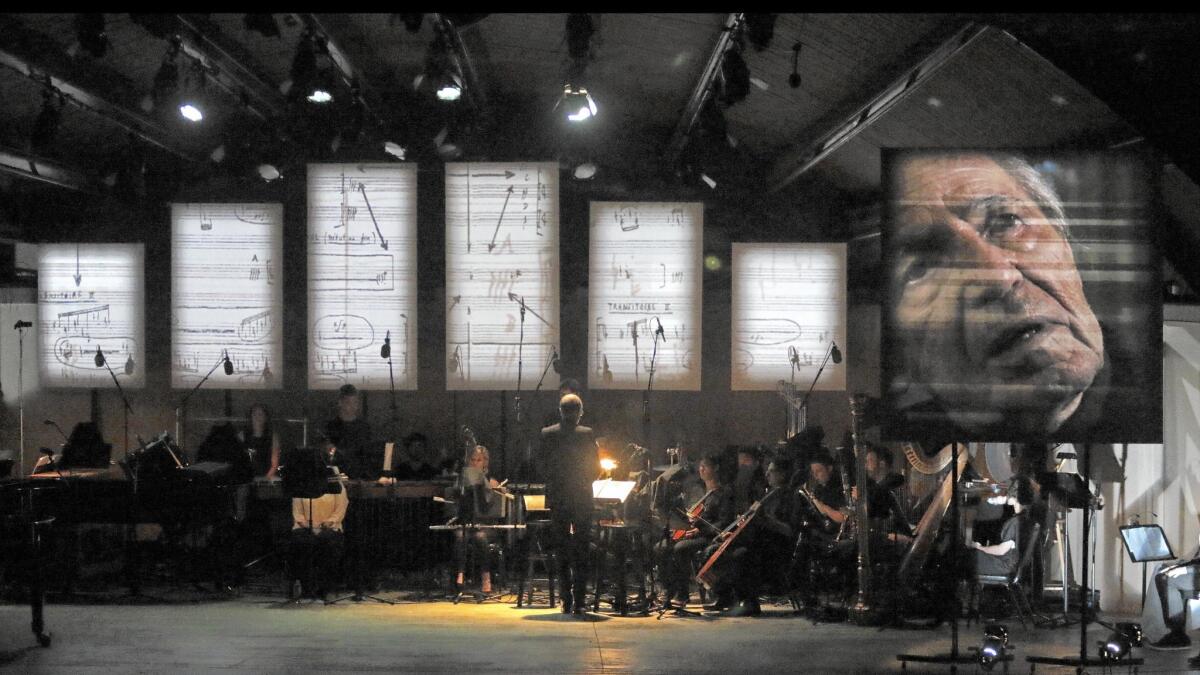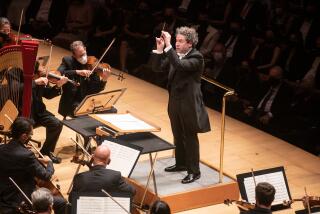Review: Ojai Music Festival celebrates icon Pierre Boulez’s 90th birthday

Portrait of Pierre Boulez, right, is part of the Ojai Music Festival’s Frank Gehry-designed multimedia set.
Tributes this year to Pierre Boulez’s 90th birthday have been plentiful in Europe and will continue to be at summer festivals. In America, where the revolutionary French composer has always been more admired as a conductor than for his music, not so much.
In fact, America’s best-known contributions to late 20th century and 21st century music — Minimalism, neo-Romanticism, improvisation, the New York School avant-garde, the infusion of pop culture into classical music — have been either a direct reaction against Boulezian complexity and dogma or American obliviousness to foreign influence.
The Ojai Music Festival is a different story. Although Boulez has had a major presence in the U.S., notably as music director of the New York Philharmonic in the 1970s, Ojai served as his most consistent American musical and spiritual haven. He was music director seven times between 1967 and 2003.
Wednesday night, the festival paid tribute to Boulez with “A Pierre Dream,” a multimedia tribute to Boulez with a remarkable stage design by Frank Gehry.
More remarkable still, the following four days and nights of this year’s expanded festival, with percussionist and conductor Steven Schick as music director, presents a vast collection of work by nearly 50 composers, most contemporary and American, meant to put Boulez in a broad and not necessarily copacetic context.
“A Pierre Dream” sets a beguiling scene for the festival. Gehry designed a dozen rectangular screens. Six are held on poles and carried by actors, who move in intricate patterns around the stage while imagery is projected on them with astonishing accuracy, creating a magical visual counterpoint to the structural fluidity of Boulez’s music.
The projections include archival footage of Boulez speaking and conducting. We see him with Stravinsky. We see him last year at home, frail but feisty. We see the usually formal Boulez in swinging ‘60s London wearing a polka-dot shirt straight out of Carnaby Street.
Created by British composer and writer Gerard McBurney for the Chicago Symphony, the most Boulez-friendly orchestra this season, the 90-minute portrait of Boulez felt at Ojai as though he might be a curiously progressive American in the Thoreau, John Cage and Gehry tradition. If you don’t move you stay paralyzed, Boulez observes. You cannot make new music out of old material, he explains, just like 20th century architecture needed new materials like glass and steel.
Near the end of the production, Boulez says that art should not be thought of as operating on a trajectory but is more like a tree. We go from moment to moment, a branch at a time. The moment is what matters. A marvelously tangled tree grows before our eyes. We think we understand its structure, but we can never fully grasp its meaning.
This, however, simplifies Boulez’s biases. Great art, he says, provokes you to discover yourself. But he is also a composer who has always thought about his place in history, not only as a conductor tirelessly revisiting his influences but adamantly proscribing the future of music.
Most important, his own work, which “A Pierre Dream” does a very good of presenting, consists of constant reworking of basic musical ideas from his early pieces.
For him, one thing always leads to another, and that is a labyrinthine process he can never stop.
Wednesday night, ICE and red fish blue fish, this year’s resident ensembles in Ojai, offered dazzlingly virtuosic performances of excerpts of Boulez’s work early and late. Pianist Jacob Greenberg played “Incises,” a small piano solo written for a competition, as though it were explosive jazz.
Flutist Claire Chase uncovered a raw theatricality from Boulez’s early, adamantly serial “Sonatine.” Schick conducted excerpts from the 45-minute “Dérive 2,” which will end the festival Sunday, with breathtaking rhythmic emphasis but less attuned to the kind of expressive elegance that Boulez’s own performances emphasize.
Occasionally the presentation could be overly literal. Boulez compared the motion in a small piano piece to the quick and quiet activity of gold fish, and there, on the screens, were gold fish. He compared “Dérive 1” to the motion of an airplane, and one flew by on the screen.
This was effective in making Boulez accessible without seriously watering down the complexity of the music or the ideas, but there were occasional lapses. For all Boulez’s talk about living in the moment, he was also a composer who expected his audience to come well prepared for that moment.
His settings of Mallarmé, he once said, were meant for listeners who had already absorbed the poetry. Mellissa Hughes sang them with care. But readings of Mallarmé and of Boulez by actress Anna Bowen in a grandiloquent Broadway manner took the Americanization of Boulez too far even for Ojai, where this elegant Frenchman once good-naturedly dined at Carrows late one night when all the town’s fine restaurants had closed.
That will be the festival’s challenge. Ojai will not let Boulez’s music stand still. It will be, as never before in this way, played in an environment of new American music that arouse out of much of what Boulez has opposed, especially pop music and Minimalism.
Even spiritual havens must move or they will be paralyzed.
Twitter: @markswed
------------
Ojai Music Festival
Where: Libbey Bowl, Ojai
When: June 10 through 14. Complete schedule at https://www.ojaifestival.org.
Info: (805) 646-205
More to Read
The biggest entertainment stories
Get our big stories about Hollywood, film, television, music, arts, culture and more right in your inbox as soon as they publish.
You may occasionally receive promotional content from the Los Angeles Times.







